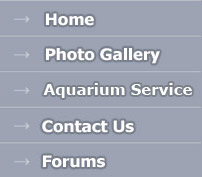Parasite Control
Two fish parasites are commonplace in the marine aquarium. These are Cryptocaryon (white spot) and Amlyoodinium (oodinium,, marine velvet, coral fish disease). The key to avoiding an infestation is to provide conditions that promote good health in the fish population. In the ocean, the fish's immune system largely protects it from infestations. In the aquarium, maintaining good health in the fishes involves, first and foremost, practicing good aquarium management. When you bring a new specimen home, place it in a separate tank for a couple of weeks to observe its behavior. This will prevent any problem that may develop in the new fish from spreading to other, established specimens. In addition, isolating new specimens in a separate tank makes the job of treating them much easier, if a need for treatment does develop. Symptoms of Infestation
Symptoms of Cryptocaryon and Amyloodinium include rapid shallow breathing, scratching, hiding, poor appetite, loss of color, and the appearance of small white dots on the fish's body and fins. These parasite problems commonly appear in fishes that have recently been subjected to some form of stress. When a fish is under stress, it is more likely to succumb to a parasite infestation. In our experience, more aquarium fishes are killed by Amyloodinium than by Cryptocaryon. In fact, we think deaths attributed to Cryptocaryon have actually been the result of Amyloodinium, with the other parasite a secondary invader. We have seen fishes recover from Cryptocaryon without treatment. This has not been the case with Amyloodinium. Further, it is known that the latter parasite produces a substance, apparently not unlike that involved in "red tides," that is toxic to fishes. This is in addition to the Amyloodinium organism's penchant for feeding upon and destroying the fish's gills, causing death by oxygen starvation if left untreated.
Diagnosis
Beginners may not be able to diagnose Amyloodinium until it is too late to save the fish. By the time external symptoms appear, the damage has already been done. Our advice to beginners is simple: if any fish in the tank appears to be breathing at a more rapid rate than the others, or more rapidly than you are accustomed to seeing as a "normal" breathing rate, treat the entire fish population promptly with copper. The breathing rate in fishes is somewhat influenced by temperature, so all the fishes in the same tank should be breathing at the same rate, under normal circumstances. Chasing a fish with a net, for example, will increase its breathing rate, but the rate soon returns to normal. This is analogous to what happens to you if you are walking down the street and have to break into a run suddenly to catch the bus.Your breathing rate will be rapid, but will return to normal as your body adjusts itself. When a fish's gills are damaged by a parasite infestation, the fish breathes more rapidly to compensate, and normal breathing does not resume until the infestation is alleviated.
Treatment Procedure
Should treatment for white spot or coral fish disease become necessary, the only truly effective medication is copper. Use an ionic copper medication, and use a copper test kit to determine when the correct dosage has been added to the treatment tank. A copper concentration of 0.15 - 0.20 ppm is most effective. Below 0.15 ppm, the treatment will not be effective; above 0.20 ppm, the copper is stressful to the fishes. Copper medications should never be used in a tank containing invertebrates, as most invertebrates are rapidly killed by therapeutic levels of copper. This is another good reason to have a separate treatment tank.
Angelfishes are somewhat more sensitive to copper treatment. Before exposing an infected angelfish to copper, attempt to cure the problem with a medication containing formaldehyde and malachite green, applied according to the manufacturer's directions. If the infestation is severe, however, copper treatment should be started immediately.
Signs of Cure
Fishes usually resume normal breathing within a day or two of beginning copper treatment. Spots may disappear overnight, as if "by magic," but this is a normal part of the parasite's life cycle. Do not assume all is well if this happens. Continue treatment for two weeks, no matter what. Meanwhile, try to determine what may have been the source of stress, and eliminate it if possible. If the specimen is new, chances are the stress of capture and movement were the only problem.
Properly administered copper treatment is rapidly and universally effective in dealing with Cryptocaryon and Amyloodinium. If results are not achieved within 48 hours, it is likely that the problem has been mis-diagnosed. Seek advice immediately regarding alternative action that should be taken. The chances of curing any disease problem in marine fish are best when water conditions and nutrition are correct, and the problem is treated promptly.


